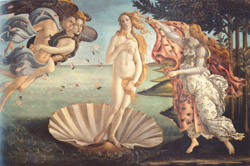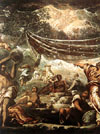|
|
Apartments in Florence, Perugia, Rome, Sorrento and Positano |




|
|
|
|
- You are in: Home » musei » UFFIZI GALLERY - Florence -
UFFIZI GALLERY - Florence -

Designed and built by Vasari in the second half of the 16th century at the request of Cosimo I de’ Medici, the Galleria degli Uffizi is in the Palazzo degli Uffizi, which originally housed the city’s administrators, judiciary and guilds. It was, in effect, an office block (uffizi means offices). Vasari also designed the private corridor that links the Palazzo Vecchio and the Palazzo Pitti. Known as the Corridoio Vasariano, it is, at the time of writing, lined with paintings and can be seen only on a guided tour. Cosimo’s successor, Francesco I, commissioned the architect Buontalenti to modify the upper floor of the Palazzo degli Uffizi to house the Medici’s growing art collection.
The gallery now houses the family’s private collection, bequeathed to the city in 1737 by the last of the Medici, Anna Maria Ludovica, on condition that it never leave the city. Although over the years sections of the collection have been moved to the Museo Archeologico, the Galleria degli Uffizi still houses the world’s greatest collection of Italian and Florentine art. Painting from Firenze’s churches have also been moved to the gallery. Partly The extraordinary wealth of the collection and the sheer number of famous works make one visit insufficient. If You are in Firenze for three or four days try to spend at least two blocks of three or so hours in the gallery, spread over a few days. Before heading upstairs, visit the restored remains of the 11th century Chiesa di San Scheraggio, which was largely destroyed during the construction of the gallery and its apse incorporated into the structure of the palazzo. Upstairs inside the gallery, the first rooms feature worksby Tuscan masters of the 13th and early14th centuries. Room 2 is dominated by three paintings of the Maestà by Cimabue, Giotto and Duccio di Buoninsegna. All three were once altarpieces in Florentine churches. Also in the room is Giotto’s polyptych Madonna col Bambino Gesù, Santi e Angeli (Virgin and Child with Angels and Saints). Room 3 traces the Sienese school of the 14th century. Of particular note is Simone Martini’s shimmering Annunciazione (Annunciation), considered a masterpiece of the school and Ambrogio Lorenzetti’s triptych Madonna col Bambino e Santi (Madonna and Child with Saints).
Rooms 5 and 6 house examples of the international Gothic style, among them Adorazione dei Magi (Adoration of the Magi) by Gentile da Fabiano. Room 7 features works by painters of the early 15th century Florentine school, which pioneered the Renaissance. There is one panel (the other two are in Paris’ Louvre and London’s National Gallery) from Paolo Uccello’s La Battaglia di San Romano (Battle of San Romano), as well as Piero della Francesca’s portraits Battista Sforza and Federico da Montefeltro and Madonna col Bambinopainted jointly by Masaccio and Masolino. In the next room is Fra Filippo Lippi’s delightful Madonna col Bambino e due Angeli (Madonna and Child with Two Angels). The Botticelli rooms (Nos 10 to 14) are considered the gallery’s most spectacular. Highlights are the La Nascita di Venere (Birth of Venus) and Allegria della Primavera (Joy of Spring). Room 15 features Leonardo’s Annunciazione, painted when he was a student of Verrocchio. Room 18, known as the Tribuna, houses the celebrated Medici Venus, a 1st century BC copy of a 4th century BC sculpture by the Greek sculptor, Praxiteles. The room also contains portraits of various Medici. The great Umbrian painter, Perugino, who studied under Piero della Francesca and later became Raphael’s master, is represented in Room 19, as well as Luca Signorelli. Room 20 features works from the German Renaissance, including Dürer’s Adorazione dei Magi. Room 21 has works by Giovanni Bellini and his pupil, Giorgione. Peek through the railings to see the 15th to 19th century works in the Miniatures Room and then cross into the western wing, which houses works of Italian masters dating from the 16th century.
Room 25 features Michelangelo’s dazzling Sacra Famiglia (Holy Family) and in the next room are works by Raphael, including his Leo X and Madonna del Cardellino. Room 28 boasts seven Titians, including Venere D’Urbino (Venus of Urbino). Rooms 29 and 30 contains works by comparatively minor northern Italian painters, but Room 31 is dominated above all by Venezia’s Paolo Veronese, including his Sacra Famiglia e Santa Barbara (Holy Family with St Barbara). In Room 32 it is Tintoretto’s turn. He is accompanied by a few Jacopo Bassano canvasses. Rooms 33 and 34 were open but still being organised at the time of writing. Room 35 is closed pending reorganisation. For some reason the numbering starts at Room 41 after this. This room is given over mostly to non-Italian masters such as Rubens and Van Dyck. The beautifully designed Room 42, with its exquisite coffered ceiling and splendid dome, is filled with Roman statues. Caravaggio dominates Room 43, while Rembradt and Jan Breughel the Elder feature in Room 44. In Room 45 there are 18th century works by Canaletto, Guardi and Crespi, along with a smattering of foreigners such as the Spaniard Goya. The gallery is open from 8.30 am to 10 pm Tuesday to Saturday (6.30 pm in winter) and to 8 pm on Sunday (1.50 pm in the winter).
museums archive
|
|
|
|
|
|
| TOP DESTINATIONS
|
| Adria Coast, Aeolian Islands, Alessandria, Altopiano Delle Rocche, Amalfi Coast, Aosta, Assisi, Asti, Bari, Brescia, Capo Vaticano, Capri, Catanzaro, Chianti, Cilento, Cinque Terre, Coast Of Marche, Conero Coast, Dolomites, Egadi Islands, Elba, Florence, Garda Lake, Gargano, Ischia, Italian Riviera, Lake Como , Langhe Piedmont, Lecce, Lucca, Lunigiana, Macerata, Mantova, Maremma Tuscany, Monferrato, Montepulciano, Naples, Perugia, Pesaro Urbino, Pisa, Pistoia, Positano, Prato, Procida, Riviera Of Palms, Rome, Salento Coast, Salerno, San Gimignano, Sardinia, Sicily, Siena, Sorrento, Terni, Tiber Valley Of Tuscany, Treviso, Turin, Val Gandino, Veneto, Venice, Viterbo |
|
|





